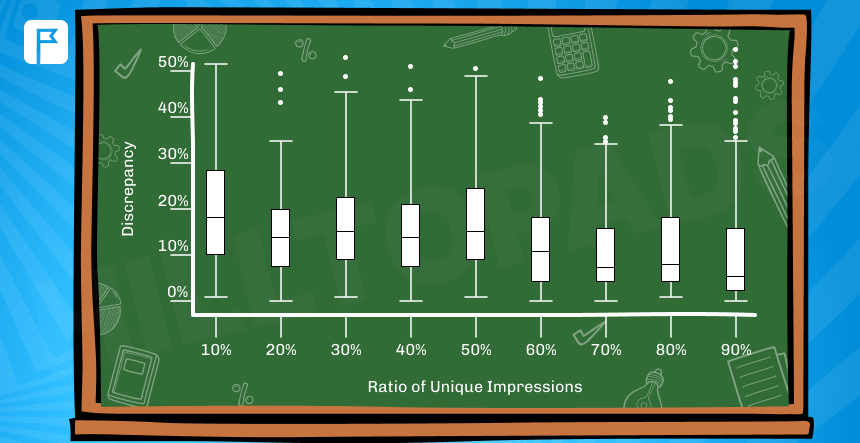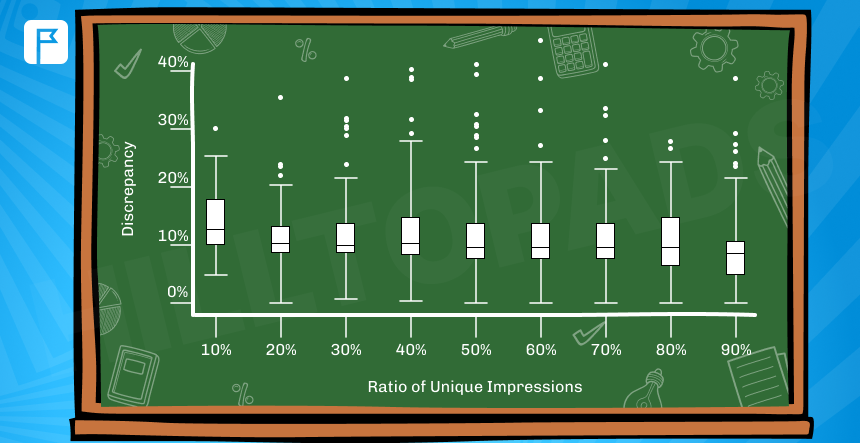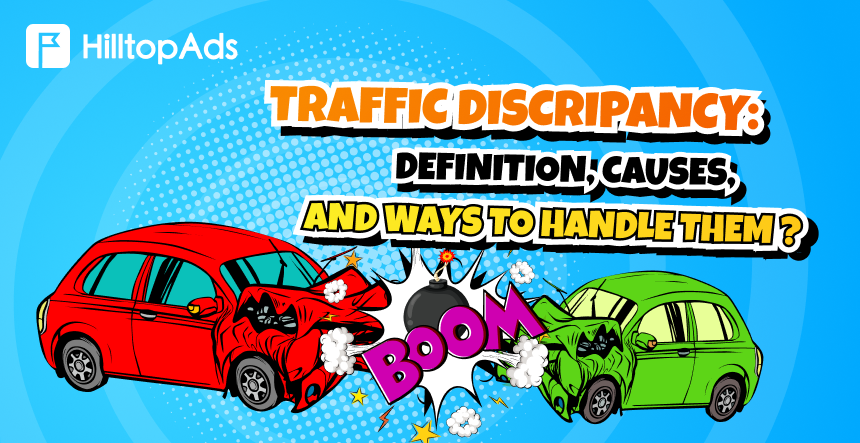Les statistiques ne correspondent pas ? Nous savons par expérience à quel point cela peut être frustrant et déroutant. Mais ne vous inquiétez pas ; l'équipe de HilltopAds vous fournira toutes les instructions nécessaires pour résoudre ce problème une fois pour toutes. Si vous voulez savoir ce que sont les divergences de données, pourquoi elles se produisent et comment les éviter et les éliminer, allez jusqu'au bout !
Suivi des divergences : Définition, causes, moyens de les éviter et de les éliminer
Définition
L'écart de suivi est la différence entre les données rapportées par deux plateformes qui surveillent la même campagne publicitaire ou le même flux de trafic. Il s'agit généralement de systèmes de suivi et de plateformes ad network.
Supposons que votre campagne publicitaire ait obtenu AAA impressions dans les statistiques de HilltopAds. En revanche, le tableau de bord de l'outil de suivi indique que le volume de trafic n'est que de BBB (BBB < AAA). L'écart de suivi sera alors calculé comme la différence entre les deux. Pour des raisons de commodité, les annonceurs utilisent généralement le taux d'écart (DR, %) :

Lorsqu'il s'agit de disparités, il est important de se rappeler qu'il est impossible d'atteindre DR=0% en raison de la nature même de ce phénomène. D'après notre expérience, DR=0% n'est observé que lorsque la source de trafic est pleine de trafic de robots. Cependant, il existe une référence solide pour le taux d'écart considéré comme acceptable : DR=30%.
L'écart de trafic est un défi important pour toutes les personnes impliquées dans le marketing d'affiliation. Étant donné que les éditeurs ne sont payés que pour le trafic de haute qualité, qui est effectivement comptabilisé par notre plateforme, le trafic perdu signifie des opportunités de monétisation manquées. Les annonceurs, quant à eux, doivent prendre en compte le coût du trafic perdu lors de la planification de leur budget et du calcul de ROI.
Les disparités de trafic liées au RTB font l'objet d'un autre article en raison de leur nature complexe.
Causes communes
Trouver la cause réelle (ou un certain nombre de causes) des discordances de données demande du temps et de l'expertise, mais il faut le faire. Sinon, vous continuerez à perdre de l'argent, des clients et du temps en vous concentrant sur d'autres aspects de la publicité et de la monétisation plutôt qu'en essayant de comprendre le phénomène de la discordance des données.
Quelle peut en être la cause ? Il y a différentes raisons aux écarts de trafic :
- Un grand nombre de redirections.
- Configuration postback incorrecte.
- Outil de suivi regroupant les impressions non uniques.
- Cookies périmés.
- Activités frauduleuses (par exemple, robots, fausses pistes).
- Différents modèles d'attribution du trafic sont utilisés par le tracker et le réseau publicitaire.
Classification
Mais tout n'est pas simple dans ce domaine. En fait, c'est plus délicat qu'il n'y paraît. Voyons ce qu'il en est. Nous identifions deux types de divergences de données : les divergences "cachées" et les divergences "explicites".
Divergences cachées
Ils se produisent lorsque ni l'annonceur ni l'éditeur ne peuvent suivre le trafic manquant. Les informations à ce sujet sont cachées dans tous les outils d'analyse (tableau de bord du tracker, rapports du réseau publicitaire). Les causes les plus courantes sont les coupures de connexion instantanées, le trafic de robots, les bloqueurs de publicité ou d'autres erreurs techniques similaires.
Divergences explicites
Elle a lieu lorsqu'au moins une des parties peut identifier la raison des disparités. Il peut s'agir, par exemple, d'un filtrage interne dû à un comportement de type "bot" ou d'un utilisateur qui quitte rapidement la page avant qu'elle ne soit entièrement chargée.
La gestion des écarts importants est l'une des tâches les plus critiques dans l'optimisation de l'achat et de la vente de trafic. C'est pourquoi nous allons approfondir les approches permettant de résoudre ces problèmes.
Comment les identifier
Maîtrisons les techniques qui vous aideront à détecter plus rapidement les disparités de données avant qu'elles ne se traduisent par des pertes d'argent indésirables. Chez HilltopAds, nous ne pouvons les identifier que lorsque les utilisateurs signalent des problèmes. Nous ne pouvons pas les prévenir plus tôt parce que les facteurs externes et les statistiques des trackers en coulisses nous restent cachés.
C'est pourquoi nous vous encourageons à surveiller de près le taux de divergence dès le début de votre campagne. Vous constatez une anomalie suspecte ? Contactez votre gestionnaire personnel HilltopAds, et nous la résoudrons ensemble !
Conseil d'expert : Vous pouvez détecter les écarts locaux en analysant des segments de trafic spécifiques (par exemple, les GEO). Cette approche vous permet de repérer les régions problématiques et d'ajuster la tarification du trafic spécifiquement pour ce marché, en laissant la partie de haute qualité de votre trafic à un coût élevé.
Comment les résoudre
À ce stade, vous comprenez probablement déjà qu'il n'est pas facile de résoudre les problèmes liés aux différences de trafic. Mais ne vous inquiétez pas-HilltopAds a quelques idées pour vous aider à vous défendre !
Afin de garantir l'exactitude des données communiquées, veuillez suivre les recommandations suivantes du chef HilltopAds Operating Officer !
Pour les annonceurs :
- Mettez en place un suivi avant de lancer la campagne publicitaire.
- Effectuez des tests de conversion avant de lancer une campagne publicitaire.
- Vérifiez si votre domaine (ou tout autre domaine utilisé dans la chaîne de redirection) est bloqué par un logiciel antivirus ou un bloqueur de publicité. Cette approche peut vous éviter de perdre des visiteurs qui ne peuvent pas accéder à votre site web en raison d'un antivirus actif.
- Vérifiez la vitesse de chargement des pages. S'il faut trop de temps à un visiteur pour voir le contenu d'un site web, l'utilisateur rebondira et l'impression ne sera pas comptabilisée dans les analyses. Les pages légères sont particulièrement importantes dans les pays en développement où la vitesse de l'internet est souvent beaucoup plus lente.
- Réduisez le nombre de redirections menant à votre offre finale. Plus il y a de redirections, moins les clients potentiels sont susceptibles d'arriver jusqu'à la page de l'offre principale. C'est une raison supplémentaire de travailler avec des sources de trafic directes plutôt qu'avec des revendeurs.
- Travaillez avec HilltopAds ! De son côté, l'équipe de HilltopAds surveille en permanence les indicateurs de réputation de domaine des principales plateformes antivirus et de Google Safe Browsing. Cela nous permet d'identifier le moment où la publicité peut devenir problématique, non seulement pour l'éditeur, mais aussi pour l'annonceur. Plus les systèmes antivirus associent une activité malveillante à votre offre, moins le public a de chances de la voir.
Pour les éditeurs :
- N'essayez pas de mélanger du trafic provenant de fournisseurs tiers. Le scénario le plus probable est que vous obtiendrez un trafic bon marché de faible qualité, qui ne passera pas à travers les détecteurs antivirus de filtrage.
- HilltopAds fournit aux éditeurs des scripts anti-bloqueurs avancés qui permettent de contourner les filtres connus et de réduire considérablement les taux de divergence.
- Nous achetons l'inventaire publicitaire dans toutes les zones géographiques et tous les ciblages à partir du site web de l'éditeur. Cela garantit que l'éditeur reçoit un taux de remplissage de 100% avec un minimum d'écart, ce qui n'est pas toujours possible lorsque l'on travaille avec des tiers. monétisation du trafic plates-formes.
Maintenant que nous connaissons tous les faits relatifs à la divergence des données, voyons dans quelle mesure ce phénomène affecte les statistiques des affiliés en fonction du type de zone publicitaire et du trafic !
L'étude exclusive sur les divergences de trafic par Hilltopads
Objectif de la recherche
Nous avons décidé d'examiner dans quelle mesure les données relatives au trafic Popunder Desktop et Popunder Mobile peuvent varier en fonction de l'unicité des impressions. En d'autres termes, existe-t-il une corrélation entre la fréquence des annonces et le nombre d'impressions ? Examinons-le !
Divergences dans le trafic mobile Popunder
Pour notre étude, nous avons recueilli des données sur les zones directes "moyennes" et "grandes" sur une période d'un mois.

Le graphique ci-dessus montre comment l'écart varie en fonction de la part d'impressions uniques (c'est-à-dire les impressions avec unicité = 1) d'une annonce dans le trafic mobile popunder.
- L'axe X représente l'unicité.
Notez qu'une valeur de 10% équivaut à l'unicité des impressions dans la plage de 10% à 20% (par rapport à l'ensemble du volume de trafic testé à ce stade), 20%-de 20% à 30%, etc.
- L'axe des ordonnées indique les valeurs d'écart.
À l'issue de cette partie de l'étude, toutes les zones peuvent être divisées en quatre groupes :
Unicité très élevée (>90%) :
Les écarts se situent entre 0% et 15% (la valeur médiane est de 6%).
Unicité élevée (60%-90%) :
Les écarts vont de 0% à 20% (la valeur médiane est de 8-10%).
Unicité moyenne à faible (20%-60%) :
L'écart se situe entre 5% et 25% (la valeur médiane est de 13%).
Unicité extrêmement faible (<20%) :
Les écarts vont de 10% à 30% (la valeur médiane est de 18%).
Par conséquent, les zones où la fréquence d'affichage des publicités est élevée ont tendance à présenter un écart de 1,5 à 3 fois plus élevé.
Divergences dans le trafic de bureau Popunder
Le graphique ci-dessous montre la distribution des valeurs d'écart en fonction de la part d'impressions publicitaires uniques pour les zones de bureau Popunder.

Voici un point important de cette partie de la recherche. En général, contrairement au cas mobile Popunder, ces zones ne peuvent pas être divisées par l'unicité ou la divergence.
L'écart médian pour toutes les zones - à l'exception de celles dont l'unicité est extrêmement faible (comme le montre le diagramme de gauche) - reste compris entre 9% et 11%.
La seule dépendance notable est que plus l'unicité est faible, plus la limite des divergences est basse. Elle passe progressivement de 4% à 90%+unicité à environ 8% à environ 30% unicité.
Conclusion
Il existe un lien étroit entre la fréquence (unicité) des impressions sur une zone et les divergences dans les données des annonceurs. En réduisant cette valeur, vous obtiendrez de meilleurs résultats pour vos campagnes publicitaires, à moindre coût, ou vous augmenterez vos revenus de monétisation sans perte inutile de trafic.
L'importance d'un reporting précis des données est également soulignée par les résultats de notre recherche. Nous avons prouvé que dans les zones où les publicités sont affichées moins souvent (unicité d'impression plus élevée), les écarts diminuent de 1,5 à 3 fois. Cette dépendance est encore plus perceptible dans les zones mobiles Popunder.
Vous avez appris toutes les bonnes pratiques pour gérer les écarts de trafic. Quelle est la prochaine étape ? Commencez à les appliquer dès aujourd'hui - visitez votre compte HilltopAds et augmentez vos profits dès maintenant !
Si vous n'avez pas encore créé de compte, cliquez sur le bouton ci-dessous pour accéder au formulaire d'inscription !



















